- Call us: 01444 237070
- Contact Us
- Stores
- Sign In / Register
- Black Friday Deals
-
- Back
- Used Cameras
- Used Accessories
- Used Lenses
- Used Video
- Used Film Equipment
- Used Stock Alert
- Used Blank Test
- Sell or Part Exchange
- All Used Black Friday Deals
- Used Clearance
- Recently Added Used Equipment
- Park Picks
- Faulty
- Trade-In
- Blog
- New in
- Call us
- Contact us
- Stores
- Sign in
- Categories
- Tips & Inspiration
- Reviews
- News
- Events
- Features
- Buying Guides
- Competitions
Fujifilm X half Compact Camera Review
The launch of the Fujifilm X half sees the arrival of a completely new compact digital camera concept. This novel camera from Fujifilm launched on 22nd May 2024 priced at £699.00, and is available in three classic Fujifilm colours including Black, Silver and Charcoal. This is not a reissue, nor any kind of revival of a past model, but rather this is an entirely new direction for digital imaging from Fujifilm.
Gareth Tried The New Fujifilm X Half Camera and It's SUPER DIFFERENT - Video Review
The X half is inspired by half-frame film cameras from the 1960s and 70s, and it takes design cues from a period where some of these offered double the exposures and a vertical frame orientation by default. Rather than replicate that technology, Fujifilm has reinterpreted the idea with a digital take by combining their expertise in film simulations, compact camera design and handling with a vertical-first layout, new gesture controls, and entirely unique shooting formats.
This is a compact for a new type of user. It’s small, stylish and easy to operate, but it also nurtures creativity, and is designed to encourage experimentation with a unique approach. It features a fixed prime lens, swipe-based controls, and there’s even a physical frame advance lever for creative diptychs, and to advance the frame. This ensures that the X half delivers a shooting experience that feels like film, and has the benefits of digital photography while being completely different from existing mirrorless compacts.
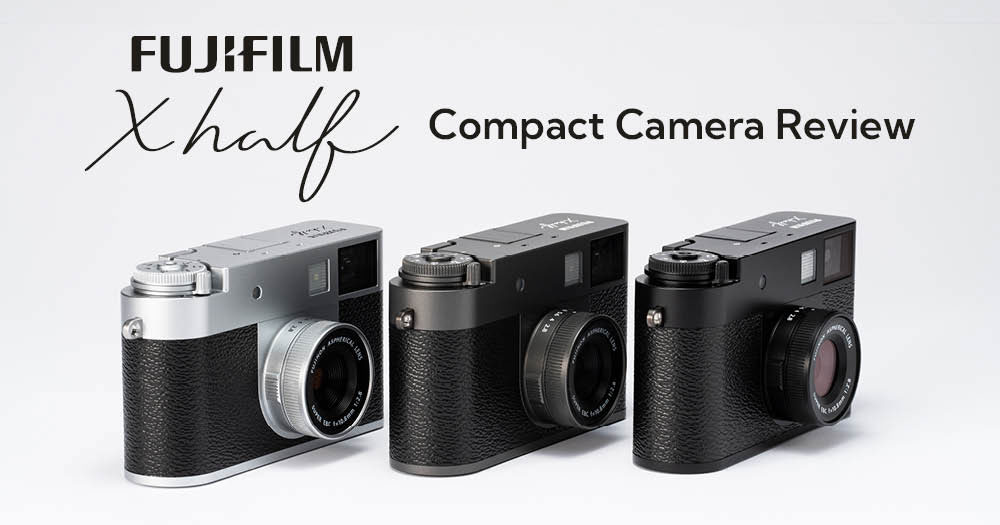
A Brief Look at Half-Frame Film Cameras
To better understand the idea behind the Fujifilm X half, it helps to go back to earlier half-frame film photography. Half-frame cameras gained popularity in the 1960s, allowing users to capture 72 images on a 36-exposure roll of 35mm film by splitting each frame in half. This meant more shots per roll, smaller cameras, and a natural vertical orientation, which was ideal for portraits, street scenes and everyday snapshots. Fast forward and the price of film today may well have played a part in Fujifilm’s decision to go digital with this model, we’ll never know! Back to the past…
Fujifilm’s own Fujica Half and Fujica Mini were among the most compact and travel-friendly half cameras of their day. These were both fixed-lens, mechanical models for photographers who were keen on portability and simplicity. The 2025 X half draws design influences from this era, particularly in its off-centre rangefinder-type viewfinder and pared-back controls, but the technology and shooting experience are entirely contemporary.

Sample image Fujifilm X half
Other brands released models with this format too. The Olympus Pen series including the legendary Pen F was arguably the most successful, thanks to interchangeable lenses and a very accessible design language. Yashica went fully electronic with the Yashica Samurai, which was an unusual camcorder-style half-frame camera from the late 1980s. Meanwhile, Konica’s Recorder offered an ultra-slim alternative, which delivered half-film style as the rest, but in vertical spool orientation!
What ties all of these together is not a nostalgic throwback, but the reworking of a clever idea for today’s storytellers and creators who favour vertical output for TikTok, Instagram Stories and other platforms. One thing I’m sure we can all agree on is the beautiful styling, which we explore next.
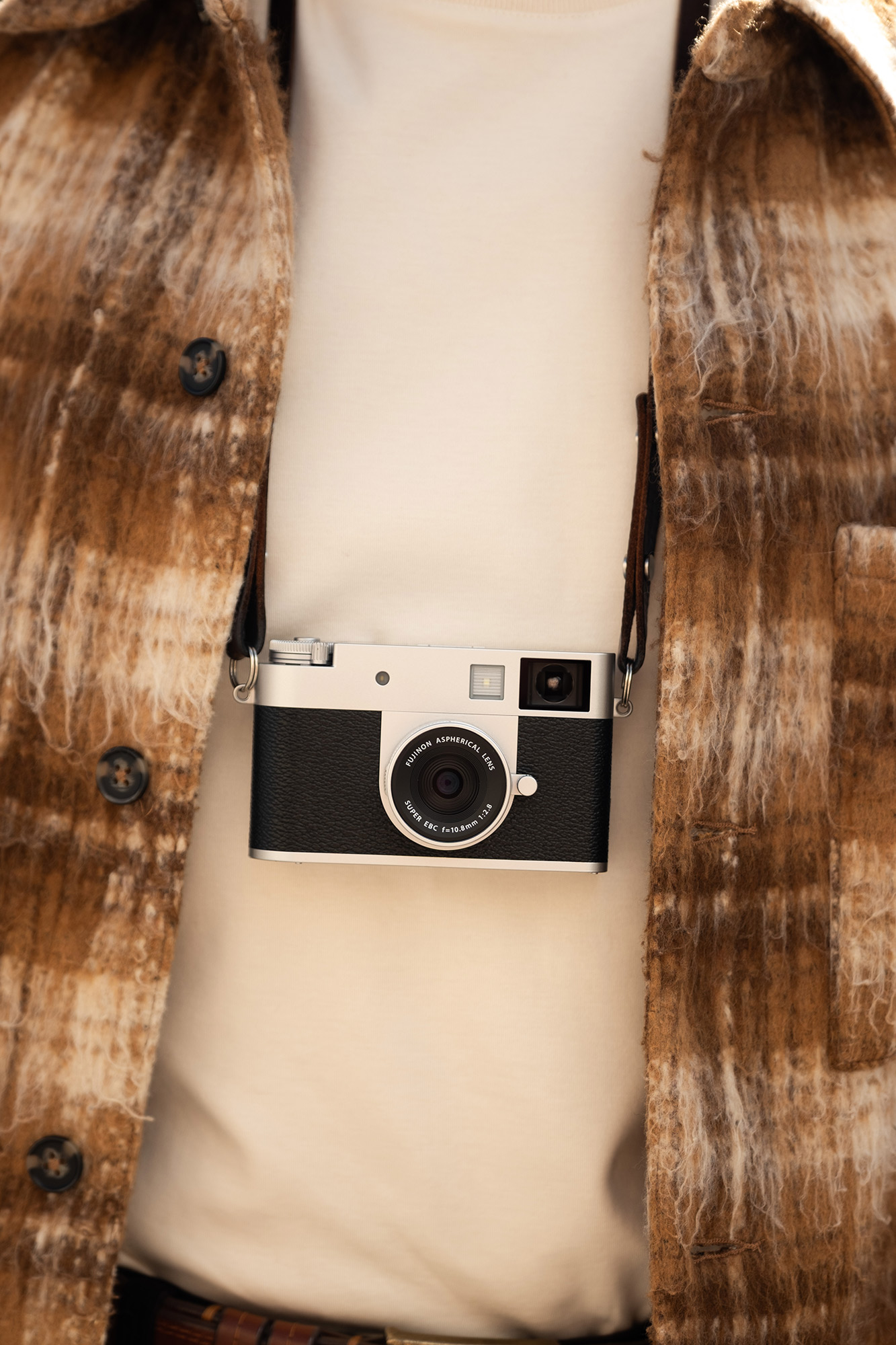
Design and styling
With even a casual glance you can tell that the Fujifilm X half is different from any current Fujifilm camera, which is of course entirely intentional. Firstly its design is optimised for vertical shooting, from the off-centre optical viewfinder (OVF) and vertically oriented touchscreen, through to the ergonomics of how it’s held, operated and handled.
This layout is a clear nod to half-frame film cameras that inspired the concept, but it’s paired with a minimalist, modern body shape by today’s standards, that strips away buttons in favour of simplicity.
You’ll also notice that there’s no mode dial, no interchangeable lens, and no clutter, just a clean, rectangular design with a fixed 32mm equivalent f/2.8 lens and a few controls in all of the right places.
One notable feature is the frame advance lever, which mimics the action of winding on film, and in this case is also used to activate the second image in the X half’s 2-in-1 picture mode. It adds an intentional, physical step to the shooting process, by connecting the digital experience with that of analogue film shooting. In a world ever more dominated by AI technology, it feels good to return to analogue controls, even if they are surrounded by digital intent.
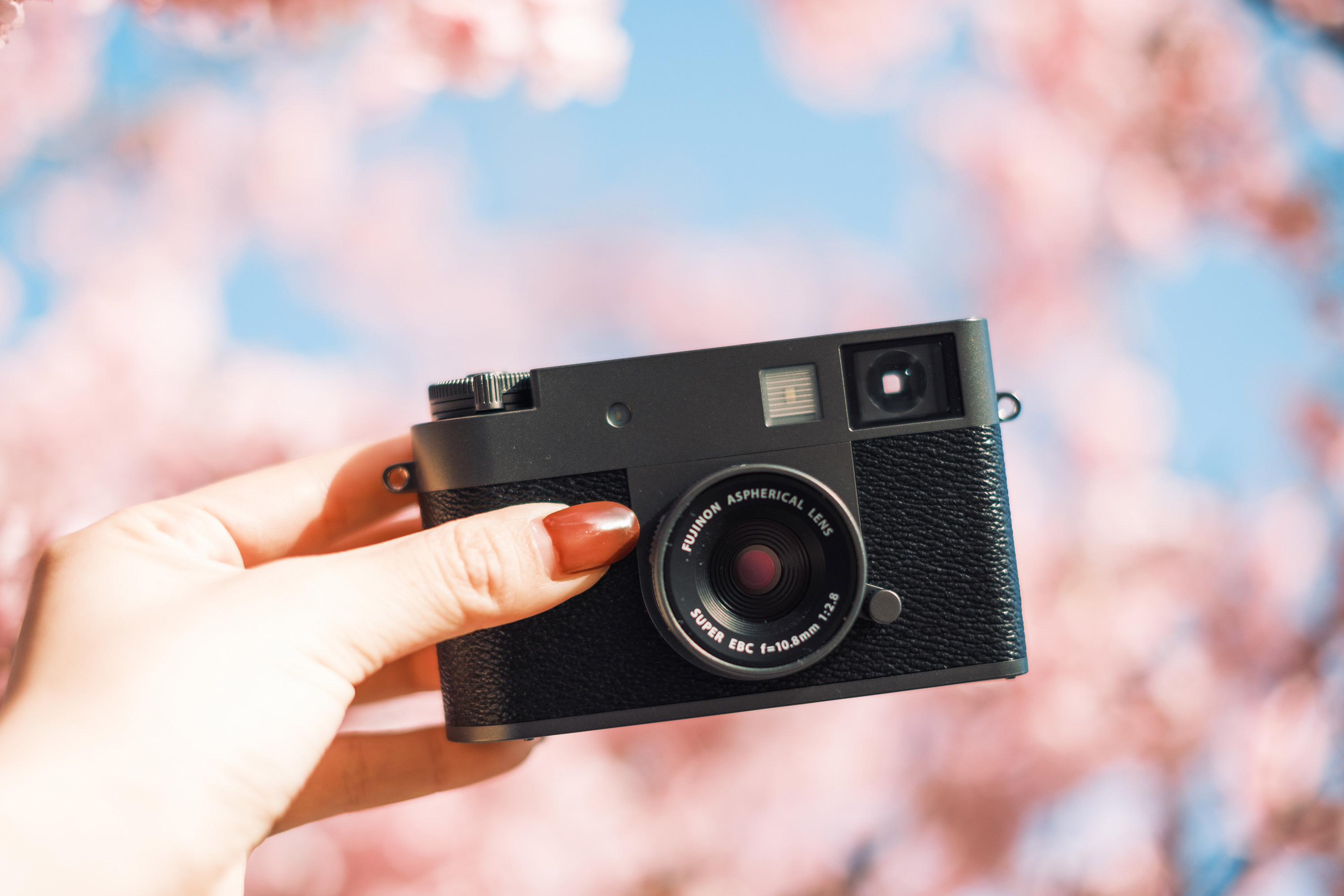
Shooting Formats and Creative Modes
The Fujifilm X half offers JPEG-only shooting, and helps with framing in a way that few digital cameras ever have, by turning everything vertical. Its native 3:4 vertical aspect ratio mirrors the orientation of half-frame film, and the camera’s body, screen and UX are all designed around an upright perspective. Of course we’re used to this thanks to our phones, but this is a novel decision for a camera.
This format naturally suits a lot of modern social platforms from Instagram Stories and Reels, to TikTok thumbnails, Pinterest boards, and mobile-first blogs. Vertical content is no longer a compromise, and many users would consider it the default. The X half embraces vertical, making it easier and more enjoyable to shoot and share content that fits the way people view images on their phones.
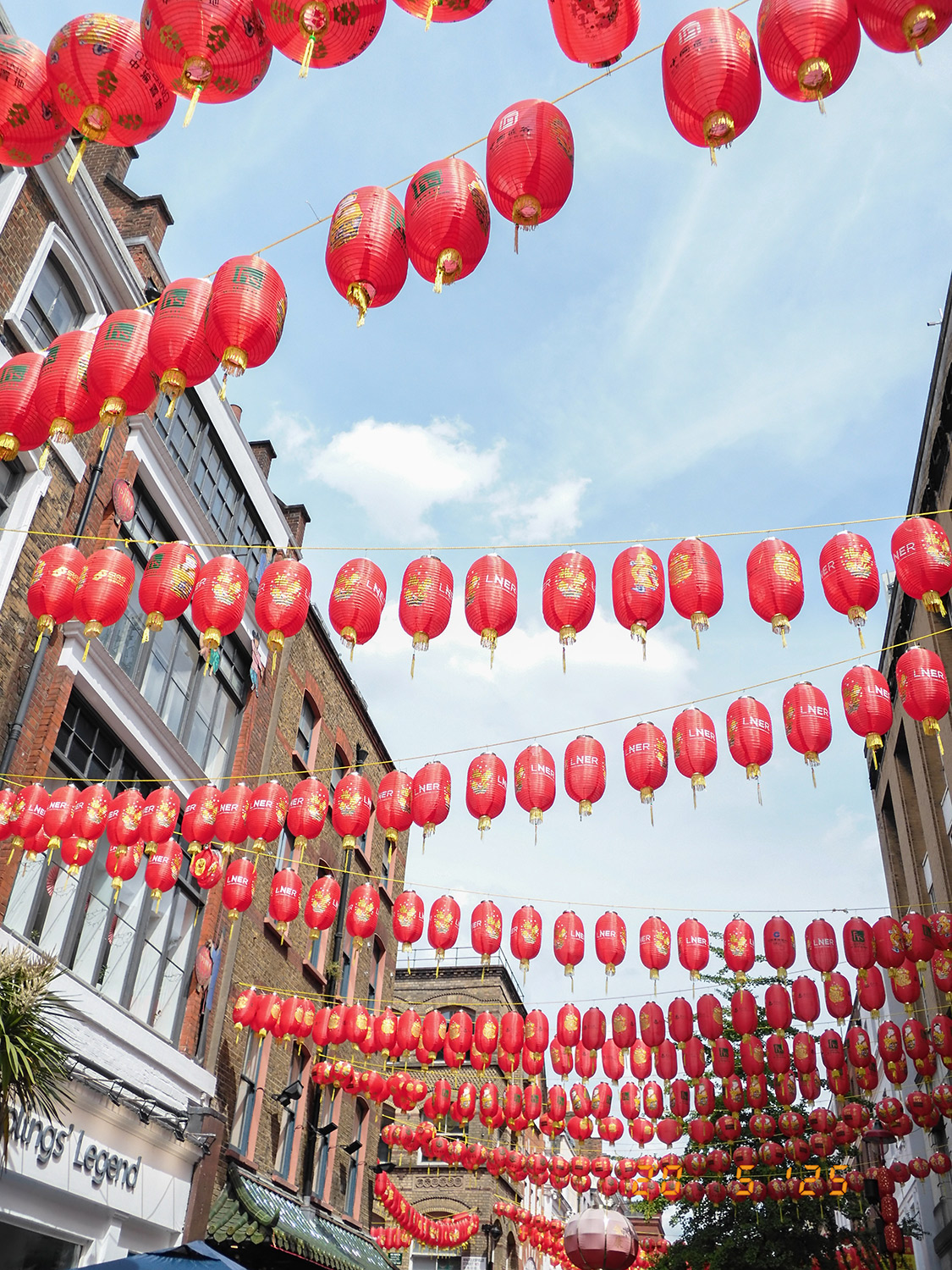
Sample image
The X half has another trick up its sleeve with its 2-in-1 shooting mode. Here, you take one image, manually wind the frame advance lever, and then capture a second. The two vertical images can then be stitched together, separated by a dividing line. The result is a single, double-width frame, which adds another avenue for side-by-side storytelling, contrasting subjects, or just a unique way to frame the story, that also fits into horizontal formats.
There’s also a built-in Date Stamp function that lets you imprint the date directly onto images and video, which is a subtle nod to film photos of the 80s and 90s, as well as some smartphones of today.
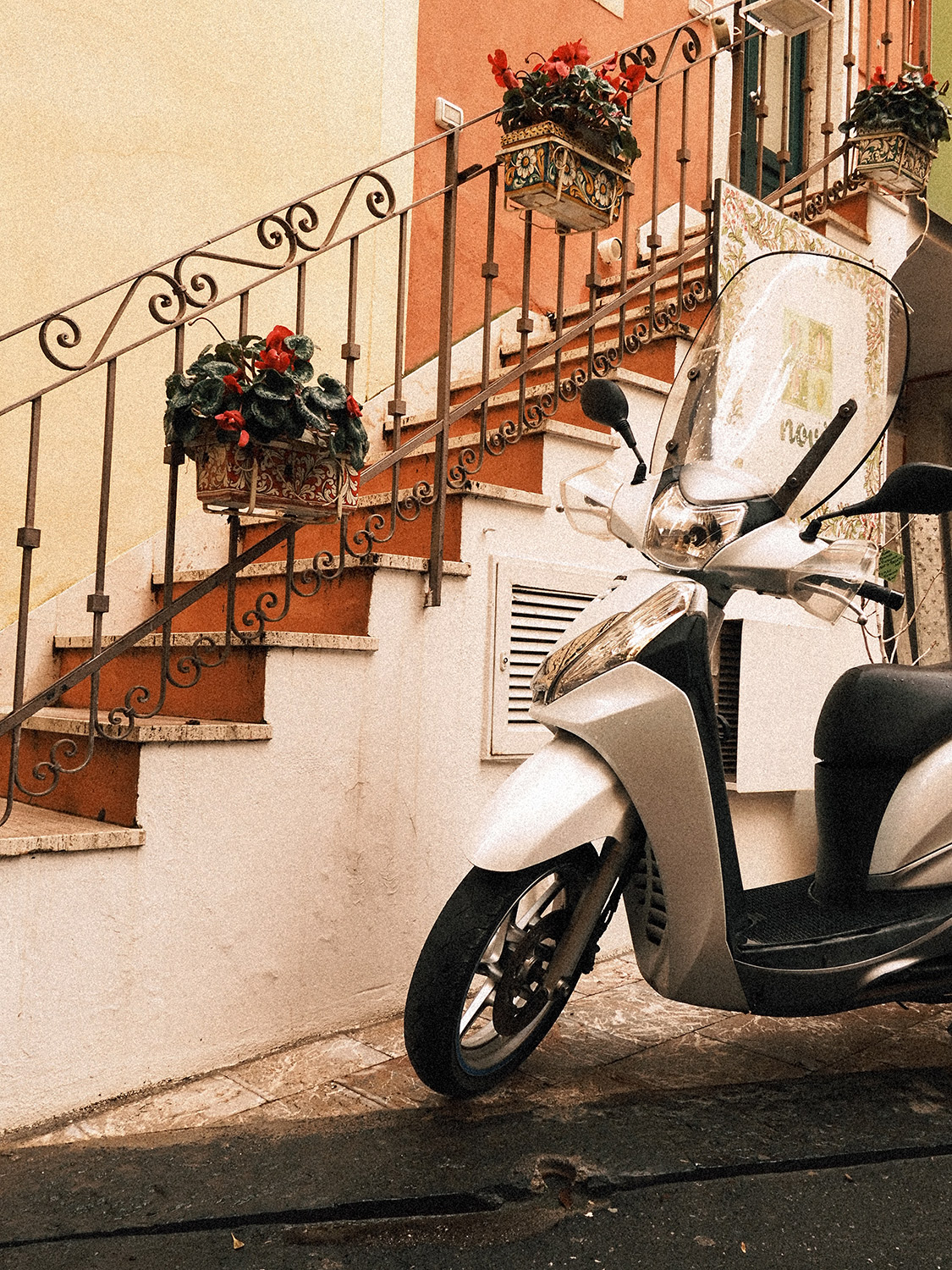
Sample image Fujifilm X half
Film Simulations
Film Simulations are a large part of Fujifilm’s digital identity, and the X half makes full use of Simulations, but with another twist. You get 13 well-known colour profiles straight out of the box, including PROVIA, Velvia, REALA ACE, ETERNA, and Classic Chrome. These deliver familiar looks for everyday shooting, catering to punchy colour or softer cinematic tones in your JPEGs.
In addition to these, Fujifilm has developed three brand-new filters exclusive to this model with film-inspired Light Leak, Expired Film, and Halation. Each one renders the imperfections and unpredictability that film users sometimes get, whether they like it or not.
These filters are baked-into JPEGs with their own character, straight out of the camera. Much like film which is tricky to edit, this camera delivers JPEGs rather than RAW, which can be edited – but you’re limited compared to RAW processing.
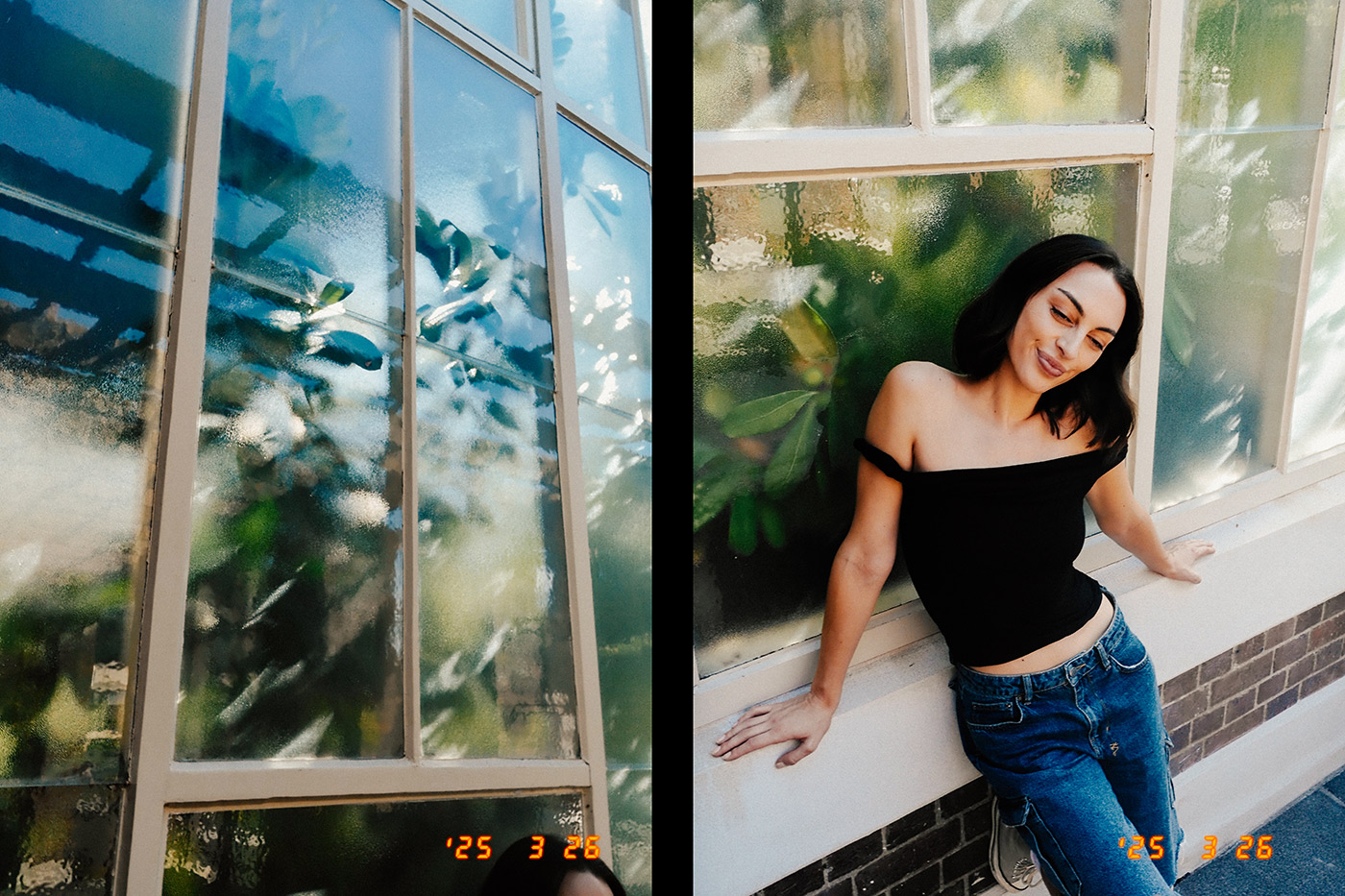
Sample 2-in-1 format with date stamp
Film Camera Mode
A major new feature is an entirely new shooting experience – Film Camera Mode. This limits the number of available frames (36, 54 or 72), disables the rear screen preview, and requires framing only through the optical viewfinder. You wind each frame, and this mode also adds a delay between capture and review, with a process that is similar to film processing. Once the images are loaded onto the dedicated X half App, you can choose to preview them as a contact sheet, with film strips et al.

New Gesture Controls
Control is based on an updated gesture system, which Fujifilm has developed for this camera. Swiping gestures are made on a vertical touchscreen, which replaces most physical buttons and menus. You swipe up, down, left or right, pinch and double-tap to access settings, pair devices or navigate modes. A secondary thin vertical LCD strip beside the main screen allows for quick changes to Film Sims or filters on the fly. We definitely gravitate to this type of control, which feels something like a smartphone crossed with an analogue camera.
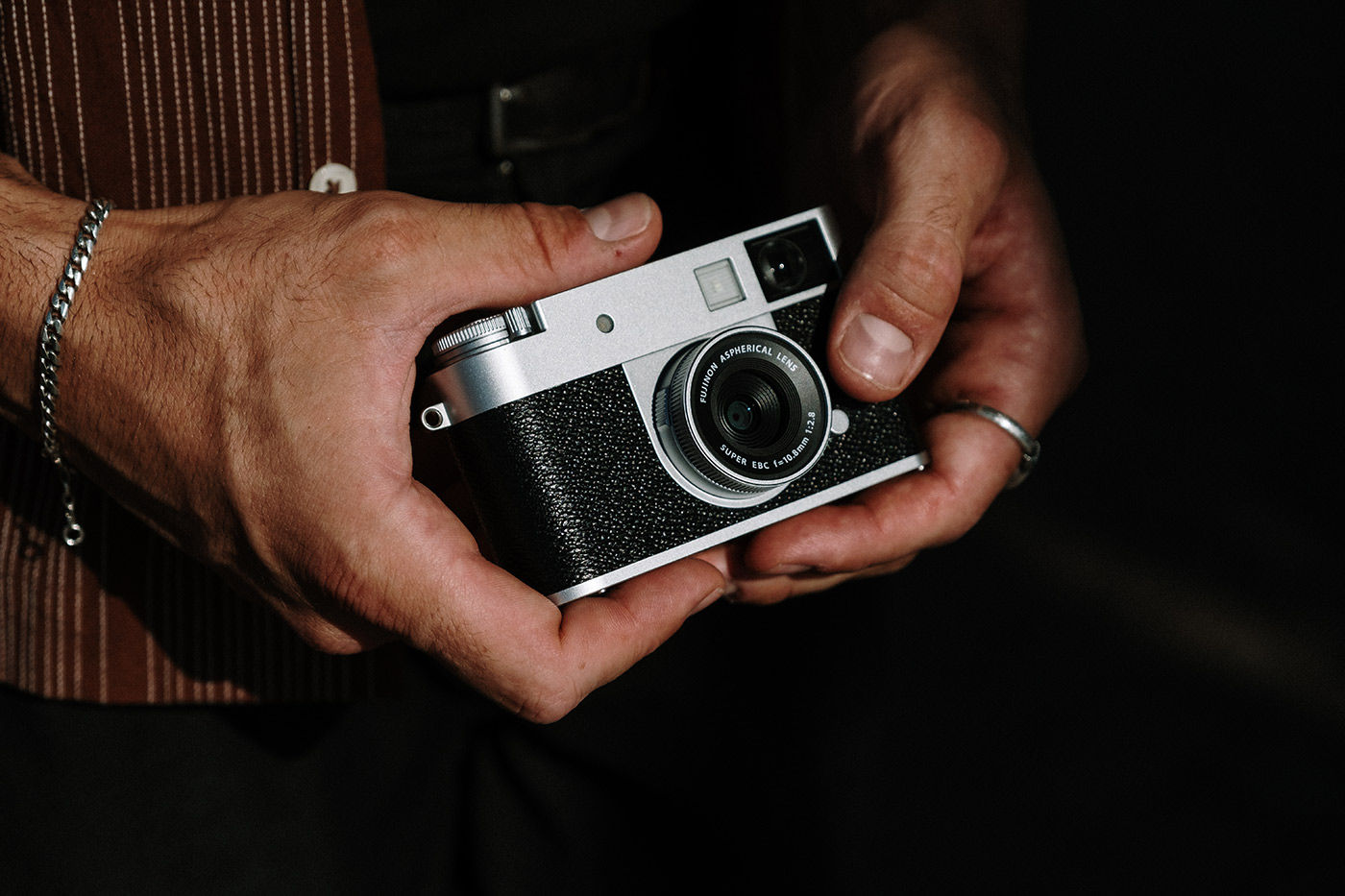
Who Is It For?
The Fujifilm X half is well priced for a generation of image-makers who don’t necessarily want or need a ‘traditional’ camera. Its form, controls and creative modes make it a natural fit for Gen Z creators, but it will also no doubt appeal to analogue enthusiasts and everyday photographers who appreciate the tactile feel, unique aesthetics and UX.
If you shoot vertically by default, share work on Instagram or TikTok, and want something much more intentional and enjoyable than a smartphone without a complete mirrorless setup, this could be right up your street.
It’s also a great option for film-curious users who want to shoot with a kind of hybrid film/digital experience, without the expense of actual film.
For collectors, casual photographers and style conscious users this is approaching the ultimate accessory, which is compact, lightweight and unique. It is definitely a great match for travel content, visual storytelling and collectors building a collection of distinctive cameras.
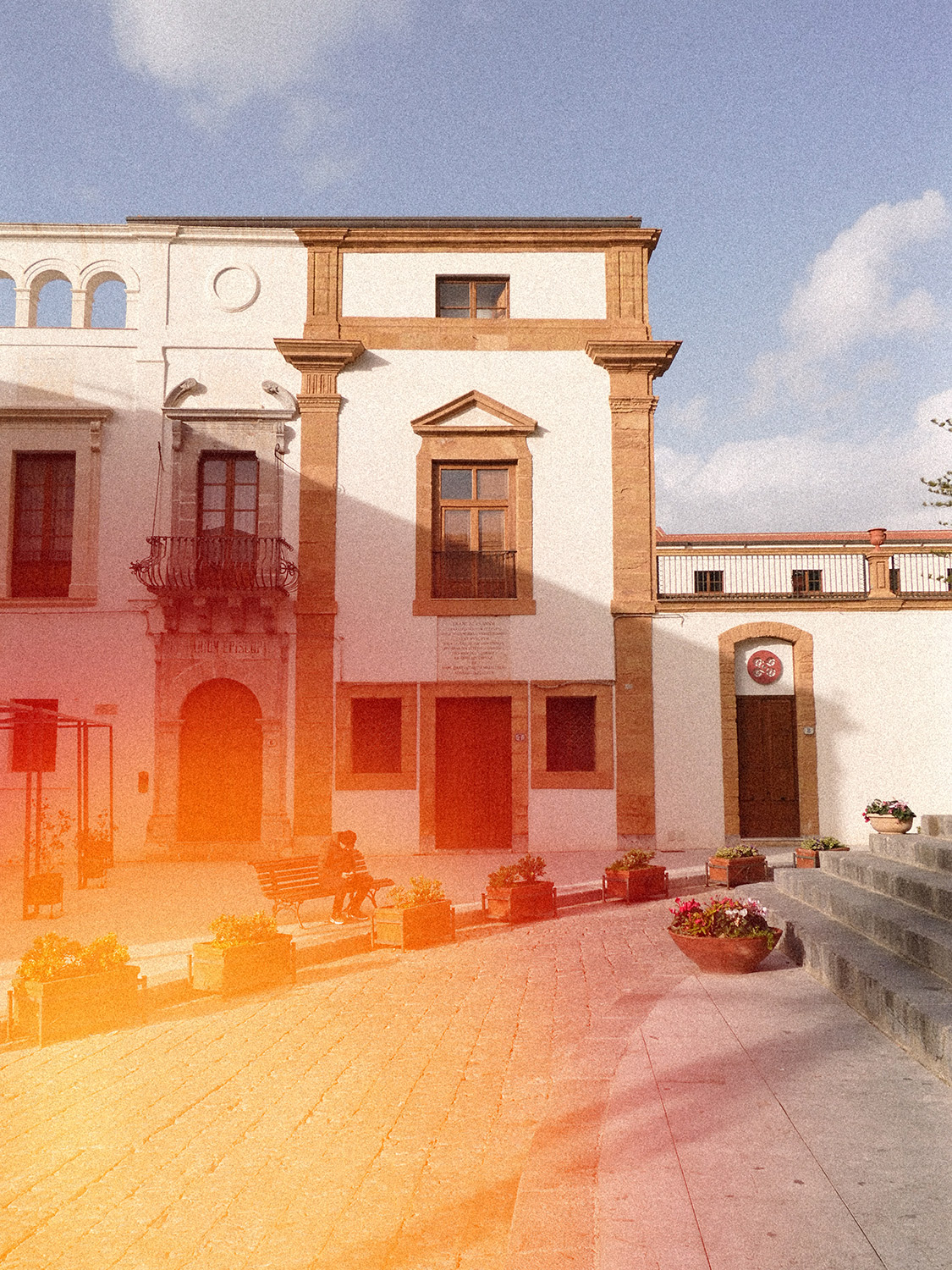
Sample image with analogue-inspired filter
Everyday Handling and accessories
The Fujifilm X half isn’t just compact, it’s also incredibly lightweight so it can easily accompany you wherever you go. At just 240g including the NP-W126S battery (which is good for about 880 shots!) and an SD card, it delivers a fully featured photographic experience without the weight. By comparison, that’s less than half the weight of the 521g X100VI.
This is also a camera you’ll probably want to keep visible. It certainly looks the business, whether worn cross-body on a rope strap like the ProMaster Strap Rope 38" Black, paired with a wrist strap (I love the Peak Design Cuff Ash Wrist Strap), or tucked into a compact bag, ready to grab at a moment’s notice.
Billingham has a recent range of compact cases, with the Billingham TEN-16 Case Black FibreNyte/Black, which is also available in a few other colours that would suit this camera.
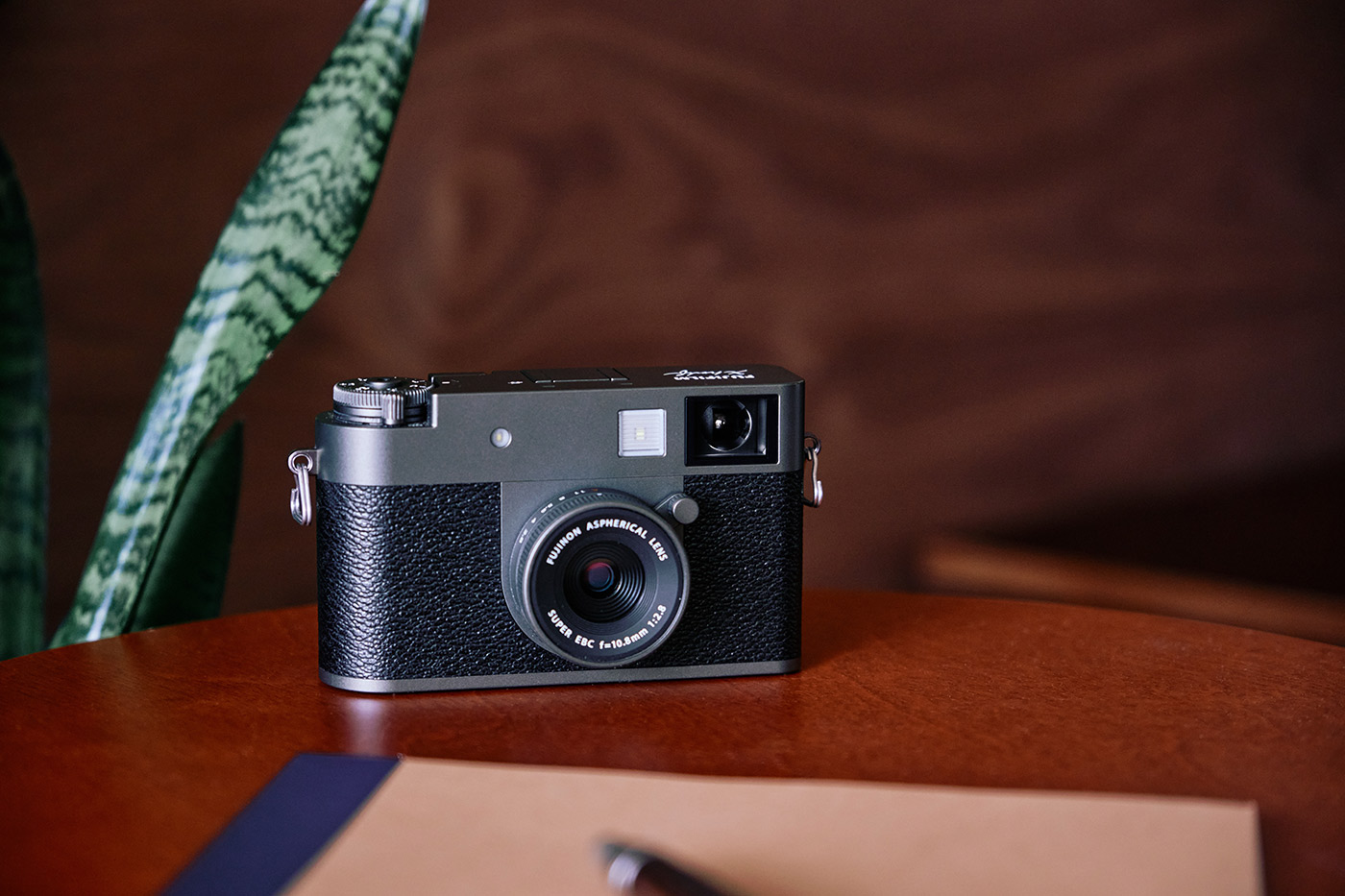
Print and Share with Instax
One of the most enjoyable ways to extend the Fujifilm X half is by adding an instax Link Series printer, turning your digital shots into classic printed photos. Whether you’re gifting a favourite shot, decorating your space, or printing a shared moment with friends, the ability to print straight from the X half App adds another creative layer.
The App connects to several current compact printer models, including:
- instax mini Link 3 which prints a classic mini film, and is ideal for collages, pinboards, or wallet-size prints
- instax SQUARE Link is a larger square format for portraits or styled images
- instax Link WIDE offers wider film that is perfect for group shots, landscapes, or side-by-side compositions like the X half’s 2-in-1 mode
These are compact, portable and simple to use, and you can learn more in our ultimate guide to instax cameras and printers. You can view your photos in the app and print directly to instax film, which is a brilliant way to share your work, make your mum a birthday print, or surprise someone with a shared memory. Mini printers like these elevate the X half to a creative ecosystem, which is ideal for journalling, mood boards or making an archive of your story in actual prints.
Note: Images captured in Film Camera Mode must first be transferred to the app before printing to instax Link printers.

Sample image Fujifilm X half
Whichever accessories you add the bottom line is that the X half is the kind of camera you’ll want to take with you whenever you head out. That’s not because it’s packed with high-end specs and features, but because it’s simple, looks great and is enjoyable to use.
It invites you to shoot differently without being pretentious. From the vertical-first layout to the frame-wind lever and swipe-based controls, every part of the experience is what makes it a unique camera.
Ready to start your own half-frame journey? Explore all three colours in more detail with the Fujifilm X half Black, X half Silver and Charcoal, or browse the rest of the range in our Fujifilm Compact Camera category.
If you’re selling unwanted equipment to upgrade, why not get the ball rolling with an instant free quotation and see how much you can make to offset against the cost of this unique compact camera.
Share this post:
By Nick Dautlich on 27/05/2025
Nick Dautlich
Senior Content Writer and Product Reviewer
Nick Dautlich is the Senior Content Writer and Product Reviewer at Park Cameras, with over 15 years of photography experience. A Sony Imaging Professional and expert reviewer, Nick has worked with major brands such as Canon, Sony and Nikon. His work is also featured on Vanguard World UK’s website, Capture Landscapes, and Shutter Evolve. Nick’s photography includes National Trust projects and magazine covers and he is passionate about landscapes and storytelling. Nick also enjoys hiking and teaching his children about nature. Learn more on his profile page.
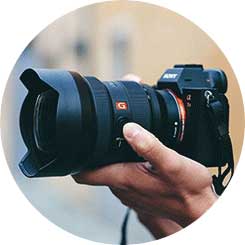
Trade in your old equipment
Fast and easy trade in service ensures your old gear is collected efficiently and you are paid quickly! It's very simple to trade in your unwanted photography gear. Just head over to our dedicated Sell or Part Exchange page, fill out the details, and we'll get back to you with an offer for your old gear. Take the cash, or put it towards the cost of your new gear. It's up to you! Find out more
sign up to the newsletter
Keep up to date on the latest photography news, events and offers. Sign up now